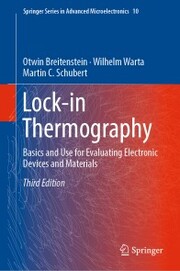Detailansicht
Lock-in Thermography
eBook - Basics and Use for Evaluating Electronic Devices and Materials, Springer Series in Advanced Microelectronics
ISBN/EAN: 9783319998251
Umbreit-Nr.: 6226518
Sprache:
Englisch
Umfang: 0 S., 12.53 MB
Format in cm:
Einband:
Keine Angabe
Erschienen am 09.01.2019
Auflage: 3/2019
E-Book
Format: PDF
DRM: Digitales Wasserzeichen
- Zusatztext
- <p></p><p>This book discusses lock-in thermography (LIT) as a dynamic variant of the widely known IR thermography. It focuses on applications to electronic devices and materials, but also includes chapters addressing non-destructive evaluation. Periodically modulating heat sources allows a much-improved signal-to-noise ratio (up to 1000x) and a far better lateral resolution compared to steady-state thermography. Reviewing various experimental approaches to LIT, particularly the commercial LIT systems available, this 3rd edition introduces new LIT applications, such as illuminated LIT applied to solar cells, non-thermal LIT lifetime mapping and LIT application to spin caloritronics problems. Numerous LIT investigation case studies are also included.</p><br><p></p>
- Kurztext
- In the last 7 years, the ?rst edition of &quote;Lock-in Thermography&quote; has established as a reference book for all users of this technique for investigating electronic devices, especially solar cells. At this time, a vital further development of lock-in therm- raphy could be observed. Not only the experimental technique was improved by applying new and better infrared cameras, solid immersion lenses, and novel t- ing strategies, but also completely new application ?elds of lock-in thermography were established by implying irradiation of light during the measurements. The two groups of new techniques are different kinds of Illuminated Lock-In Thermography (ILIT) and Carrier Density Imaging, resp. Infrared Lifetime Imaging (CDI/ILM). While ILIT is performed on solar cells, CDI/ILM is performed on bare wafers for imaging the local minority carrier lifetime and the local concentration of trapping centers. The new edition of this book implements these new developments. One new section entitled &quote;Timing strategies&quote; is added. In this, new ways are introduced to overcome previous limitations of the choice of the lock-in frequency in comparison with the frame rate of the camera. The previous diffraction limit of the spatial resolution can be overcome by a factor of up to 4 by applying so-called solid immersion lenses. This technique is introduced and its application for failure analysis of ICs, where highest possible spatial resolution is desired, is shown in another new section.
- Autorenportrait
- <p>Dr. Otwin Breitenstein received his Ph.D. in physics from University of Leipzig (Germany) in 1980 with a work on Deep Level Transient Spectroscopy (DLTS). Since 1992 he is with Max Planck Institute of Microstructure Physics, Halle, Germany, where he investigates defects in semiconductors. Since 1999 he has been using lock-in thermography, optical imaging methods, and electron microscopy, for characterizing crystalline solar cells. He is mainly interested in detecting internal shunts and generally evaluating the local efficiency of inhomogeneous silicon solar cells. He is Assistant Professor at University of Halle, Germany, giving lectures on the physics of solar cells and on advanced characterization techniques. He is author of several hundred publications in journals and at conferences and author of a book on "Lock-in Thermography" (Springer 2003, second edition 2010).</p><p>Dr. Wilhelm Warta received the Diploma and Ph.D. degrees in physics from the University of Stuttgart, Germany, in 1978 and 1985, respectively. He joined Fraunhofer Institute for Solar Energy Systems, Freiburg, Germany, in 1985, in recent years he acted as Head of the Department Characterization and Simulation/CalLab and the Deputy Director of the Division Silicon Solar CellsDevelopment and Characterization. He is the author or coauthor of close to 400 papers in reviewed journals and conferences. His research interests include the development of characterization techniques and application to crystalline silicon materials and solar cells, silicon material properties, and the impact on solar cell performance, simulation of solar cells, and cell processing, as well as solar cell calibration with highest precision.<br></p>Dr. Martin C. Schubert studied physics at the University of Montpellier, France, and the University of Freiburg, Germany. He was with the Freiburg Materials Research Centre FMF and received the Ph.D. degree in physics in 2008 in collaboration with Fraunhofer ISE from the University of Konstanz, Germany. He has been a Scientist with Fraunhofer ISE since 2008. From 2013 to 2014, he was with Japan Space Exploration Agency and Meiji University, Tokyo, Japan, as a Guest Professor in the frame of a Japan Society for the Promotion of Science research fellowship. He is currently Head of Department Quality Assurance, Characterization and Simulation at Fraunhofer ISE. Dr. Schubert received the Ulrich Gösele Young-Scientist-Award in 2013. His main interest is the identification of efficiency limitations of silicon material and solar cells with a focus on spatially resolved analyses based on Luminescence and on Thermography. <br><p></p>
